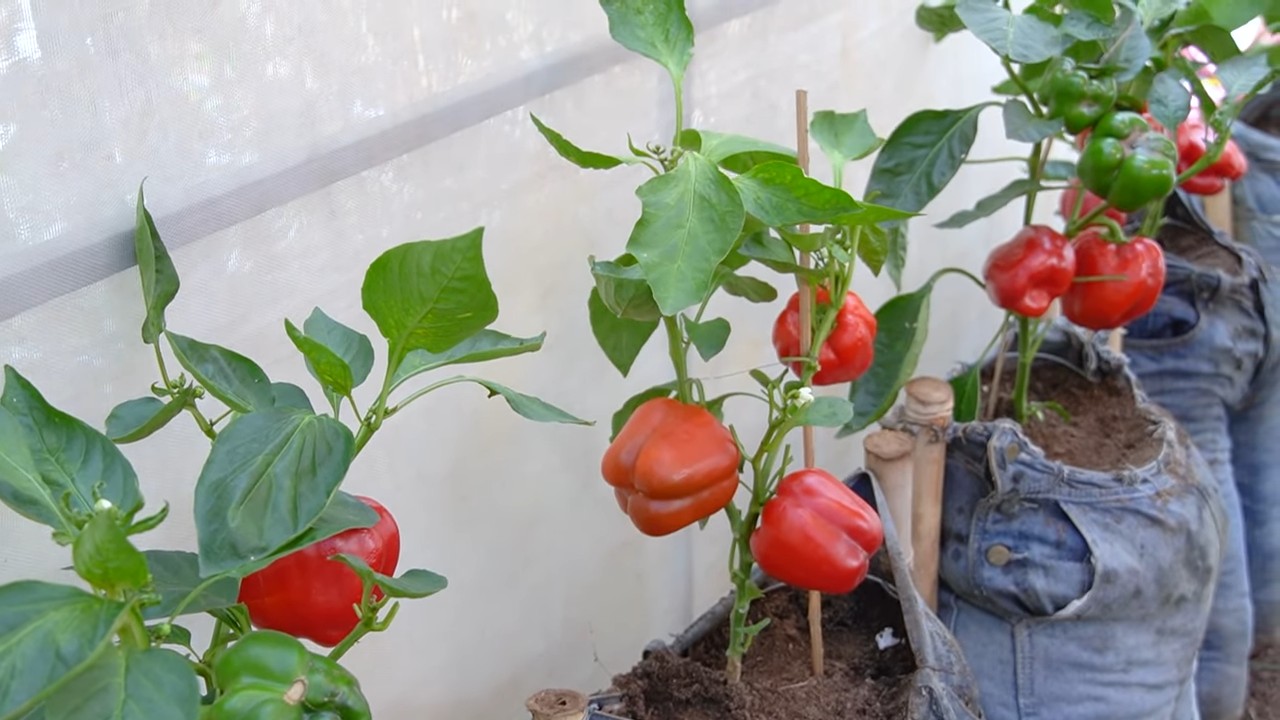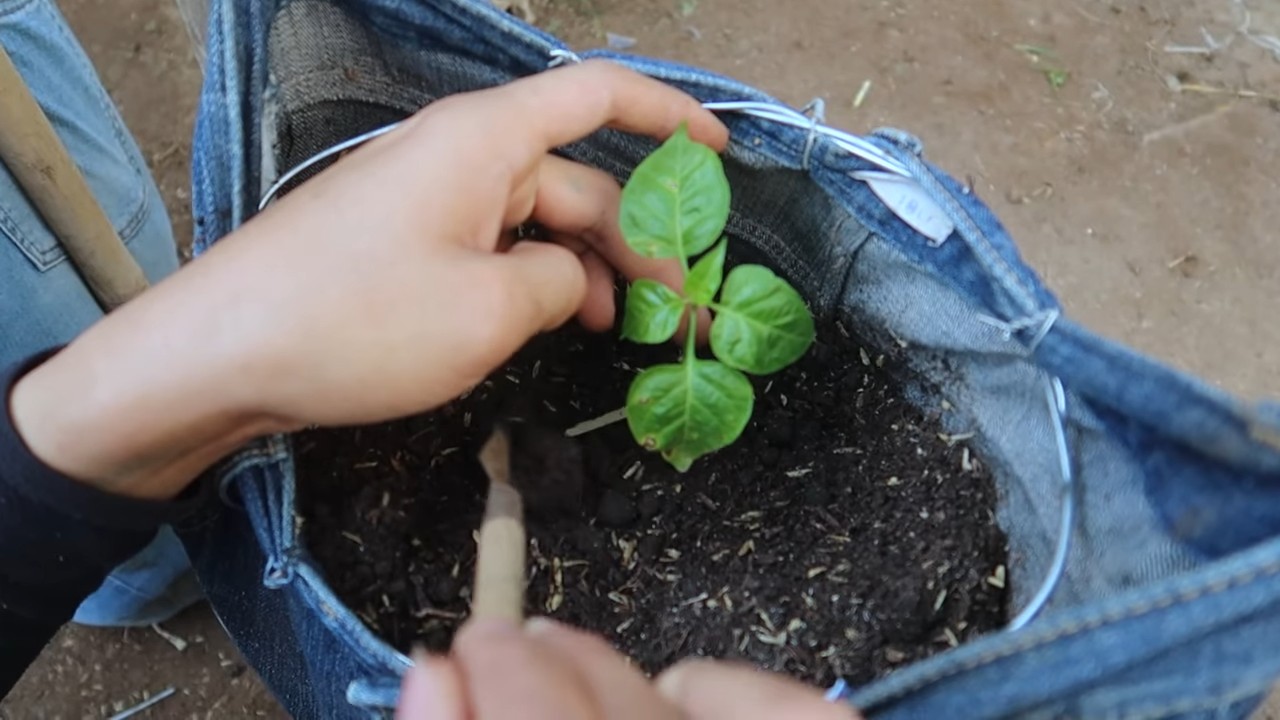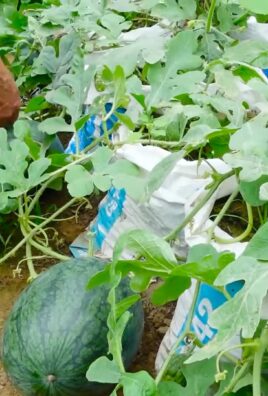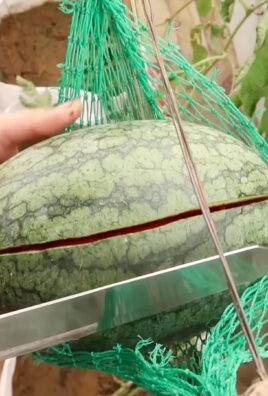Upcycled Jeans Pepper Garden: Who knew your old denim could become the hottest spot in your garden? I’m so excited to share this incredibly fun and surprisingly effective DIY project that breathes new life into your discarded jeans while providing the perfect cozy home for your pepper plants!
For centuries, resourceful gardeners have found creative ways to maximize their space and resources. From ancient hanging gardens to modern vertical farms, the spirit of innovation has always been at the heart of cultivating our own food. This upcycled jeans pepper garden taps into that same ingenuity, offering a sustainable and stylish solution for growing delicious peppers, even if you’re short on space or budget.
Let’s face it, gardening can sometimes feel intimidating. But this project is all about making it accessible and enjoyable for everyone! Maybe you live in an apartment with a tiny balcony, or perhaps you simply want to add a quirky, eco-friendly touch to your existing garden. Whatever your reason, this DIY trick is a game-changer. It’s not only a fantastic way to recycle those jeans you’ve been meaning to donate (or toss!), but it also provides excellent drainage and aeration for your pepper plants, leading to healthier, happier, and more productive yields. Plus, it’s a total conversation starter! Get ready to impress your friends and neighbors with your sustainable gardening skills and enjoy a bountiful harvest of homegrown peppers, all thanks to a pair of old jeans!

Upcycled Jeans Pepper Garden: A Stylish and Sustainable DIY Project
Hey there, fellow gardening enthusiasts! Are you looking for a fun, eco-friendly way to grow your own peppers? And maybe have a cool conversation starter in your garden? Well, look no further! I’m going to walk you through how to create an awesome pepper garden using upcycled jeans. Yes, you read that right – jeans! This project is not only a great way to give your old denim a new life, but it also adds a unique, rustic touch to your outdoor space. Let’s get started!
Materials You’ll Need
Before we dive in, let’s gather all the necessary materials. Trust me, having everything ready beforehand will make the process much smoother.
* Old Jeans (the sturdier, the better!)
* Potting Soil (lots of it!)
* Pepper Seedlings (your favorite varieties)
* Landscape Fabric or Burlap
* Scissors or a Utility Knife
* Staple Gun (optional, but helpful)
* Measuring Tape or Ruler
* Gloves (to protect your hands)
* Watering Can
* Buttons, Rivets, or Fabric Scraps (for decoration – get creative!)
* Drill (optional, for drainage holes)
Preparing the Jeans
Okay, first things first, we need to get our jeans ready for their new role as pepper planters. This involves a bit of cutting and reinforcing.
1. Choose Your Jeans: Select a pair of jeans that are relatively sturdy. Jeans with thicker denim will hold up better over time. Consider the size of the jeans as well – larger jeans will accommodate more pepper plants. I usually go for my old work jeans that have seen better days.
2. Cut Off the Legs (Optional): Depending on the look you’re going for, you can either leave the legs long or cut them off. If you choose to cut them, decide on the length. I usually cut mine off just below the knee, creating a sort of “shorts” effect. This makes it easier to manage and move the planter later on.
* Use your scissors or utility knife to carefully cut along your desired length.
* If you want a frayed look, you can pull at the cut edges to create a more rustic appearance.
3. Reinforce the Bottom: This is a crucial step to prevent the soil from spilling out. We’ll create a sturdy base using landscape fabric or burlap.
* Turn the jeans inside out.
* Measure the circumference of the leg openings at the bottom.
* Cut a piece of landscape fabric or burlap that is slightly larger than the circumference.
* Place the fabric inside the leg openings, overlapping the edges.
* Use a staple gun to secure the fabric to the inside of the jeans. Make sure the staples are close together to create a tight seal. If you don’t have a staple gun, you can use a strong adhesive or even hand-stitch the fabric in place.
4. Create Drainage Holes: Peppers need good drainage to thrive. If your jeans don’t have any existing holes in the bottom, you’ll need to create some.
* Turn the jeans right-side out.
* Use a drill or scissors to create several small holes in the bottom of each leg. I usually make about 4-5 holes per leg.
* Make sure the holes are large enough to allow water to drain freely, but not so large that soil will escape.
Planting Your Peppers
Now for the fun part – planting your pepper seedlings! This is where your garden starts to come to life.
1. Position Your Jeans: Find a sunny spot in your garden or on your patio where your pepper plants will receive at least 6-8 hours of sunlight per day. Place the prepared jeans in this location.
2. Fill with Potting Soil: Begin filling the jeans with high-quality potting soil. Make sure to use potting soil specifically designed for containers, as it provides better drainage and aeration than garden soil.
* Fill each leg of the jeans with soil, leaving a few inches of space at the top.
* Gently pat down the soil to remove any air pockets.
3. Plant Your Pepper Seedlings: Carefully remove your pepper seedlings from their containers. Gently loosen the roots before planting.
* Dig a small hole in the soil for each seedling.
* Place the seedling in the hole, ensuring that the top of the root ball is level with the surrounding soil.
* Fill in the hole with soil and gently pat it down.
* Space the seedlings appropriately, allowing enough room for them to grow and mature. I usually plant 2-3 seedlings per leg, depending on the size of the jeans and the variety of peppers.
4. Water Thoroughly: After planting, water your pepper seedlings thoroughly. This will help settle the soil and encourage root growth.
* Use a watering can to gently water the soil around each seedling.
* Avoid overwatering, as this can lead to root rot.
Adding the Finishing Touches
Now that your peppers are planted, let’s add some personal touches to make your upcycled jeans planter truly unique!
1. Decorate Your Jeans: This is where you can really let your creativity shine! Use buttons, rivets, fabric scraps, or even paint to decorate your jeans.
* Sew buttons or rivets onto the pockets or waistband.
* Cut out fabric scraps in fun shapes and glue them onto the jeans.
* Use fabric paint to create designs or patterns.
* I like to use old patches from my kids’ clothes to add a sentimental touch.
2. Add Support (Optional): If you’re growing taller pepper varieties, you may want to add some support to prevent them from toppling over.
* Insert bamboo stakes or tomato cages into the soil near the seedlings.
* Tie the pepper plants to the stakes with soft twine or plant ties.
3. Mulch (Optional): Adding a layer of mulch around your pepper plants can help retain moisture, suppress weeds, and regulate soil temperature.
* Spread a layer of organic mulch, such as straw or wood chips, around the base of the plants.
* Avoid piling the mulch directly against the stems of the plants.
Caring for Your Pepper Plants
Now that your upcycled jeans pepper garden is complete, it’s important to provide proper care to ensure your plants thrive.
1. Watering: Water your pepper plants regularly, especially during hot, dry weather. Check the soil moisture by sticking your finger into the soil. If the top inch of soil feels dry, it’s time to water.
* Water deeply, allowing the water to soak into the soil.
* Avoid watering the foliage, as this can promote fungal diseases.
2. Fertilizing: Peppers are heavy feeders and benefit from regular fertilization. Use a balanced fertilizer specifically formulated for vegetables.
* Follow the instructions on the fertilizer packaging.
* Fertilize every 2-3 weeks during the growing season.
3. Pest Control: Keep an eye out for common pepper pests, such as aphids, whiteflies, and spider mites.
* Inspect your plants regularly for signs of infestation.
* Use organic pest control methods, such as insecticidal soap or neem oil, to control pests.
4. Pruning: Pruning your pepper plants can help improve air circulation and promote fruit production.
* Remove any yellowing or dead leaves.
* Pinch off any suckers (small shoots that grow from the base of the plant).
5. Harvesting: Harvest your peppers when they reach their mature size and color.
* Use scissors or pruning shears to cut the peppers from the plant.
* Handle the peppers carefully to avoid bruising.
Troubleshooting Tips
Even with the best care, you may encounter some challenges along the way. Here are a few troubleshooting tips to help you overcome common problems:
* Yellowing Leaves: This can be caused by overwatering, underwatering, nutrient deficiencies, or pests. Adjust your watering schedule, fertilize your plants, and inspect them for pests.
* Blossom End Rot: This is a common problem in peppers caused by calcium deficiency. Add calcium to the soil by using bone meal or eggshells.
* Lack of Fruit: This can be caused by insufficient sunlight, poor pollination, or extreme temperatures. Ensure your plants are receiving enough sunlight, hand-pollinate the flowers if necessary, and protect your plants from extreme temperatures.
Why This Project Rocks
This upcycled jeans pepper garden is more than just a fun DIY project – it’s a sustainable way to grow your own food and add a unique touch to your outdoor space. By repurposing old jeans, you’re reducing waste and giving new life to something that would otherwise end up in a landfill. Plus, you get to enjoy fresh, homegrown peppers all season long!
Here

Conclusion
So, there you have it! Transforming your old jeans into a vibrant and functional pepper garden is not just a quirky DIY project; it’s a sustainable solution, a creative outlet, and a fantastic way to bring fresh, homegrown flavor right to your doorstep. We’ve walked you through the simple steps, highlighting the ease and accessibility of this upcycling adventure.
But why is this upcycled jeans pepper garden a must-try? Beyond the obvious environmental benefits of repurposing denim waste, this project offers a unique aesthetic appeal. Imagine the rustic charm of denim planters adorning your balcony, patio, or garden. Each pair of jeans tells a story, and now, that story continues with the vibrant hues of ripening peppers. It’s a conversation starter, a testament to your resourcefulness, and a beautiful addition to any space.
Furthermore, this DIY project is incredibly adaptable. Feel free to experiment with different types of peppers. From the mild sweetness of bell peppers to the fiery kick of habaneros, the choice is yours! Consider using different washes and styles of jeans to create a visually diverse garden. You could even add embellishments like buttons, patches, or paint to personalize your denim planters further. Think about creating a tiered system by stacking smaller jean planters on top of larger ones for a dramatic vertical display.
Don’t limit yourself to just peppers either! While this guide focuses on peppers, the same principles can be applied to growing other herbs and vegetables. Imagine a denim planter filled with fragrant basil, mint, or even compact tomato varieties. The possibilities are truly endless.
We encourage you to embrace the challenge and embark on this rewarding DIY journey. It’s a fantastic way to connect with nature, reduce waste, and enjoy the satisfaction of growing your own food. The process is surprisingly therapeutic, and the results are undeniably delicious.
So, grab those old jeans, gather your supplies, and get ready to create your very own upcycled jeans pepper garden. We are confident that you will be amazed by the transformation. And most importantly, we want to hear about your experience! Share your photos, tips, and variations with us. Let’s inspire each other to embrace sustainable living and creative upcycling. Use the hashtag #UpcycledJeansPepperGarden on social media so we can all see your amazing creations! We can’t wait to see what you come up with! Happy gardening!
Frequently Asked Questions (FAQ)
What type of jeans works best for this project?
Almost any type of jeans can be used for this project, but thicker denim tends to hold its shape better and last longer. Avoid jeans with large holes or excessive wear and tear in the areas that will be used for the planter. Consider the size of the jeans as well; larger jeans will naturally create larger planters, suitable for larger pepper plants or multiple smaller plants. Experiment with different washes and styles to create a visually interesting garden. Stretch denim can also be used, but it may require additional support to maintain its shape.
How do I ensure proper drainage in my denim planters?
Drainage is crucial for the health of your pepper plants. Before adding soil, create a drainage layer at the bottom of the jeans. You can use materials like gravel, pebbles, broken pottery shards, or even packing peanuts. This layer will prevent the soil from becoming waterlogged and help to avoid root rot. Additionally, consider poking small holes in the bottom of the jeans legs to allow excess water to escape. Be careful not to make the holes too large, as this could cause soil to leak out.
What type of soil should I use for my pepper plants?
Pepper plants thrive in well-draining, nutrient-rich soil. A good potting mix specifically formulated for vegetables is ideal. You can also amend regular potting soil with compost or other organic matter to improve its fertility and drainage. Avoid using garden soil, as it can be too heavy and compact, hindering root growth. Consider adding perlite or vermiculite to the soil mix to further enhance drainage and aeration. A slightly acidic to neutral pH (around 6.0 to 7.0) is optimal for pepper plants.
How often should I water my pepper plants in denim planters?
The watering frequency will depend on several factors, including the weather, the size of the planter, and the type of soil used. Generally, you should water your pepper plants when the top inch of soil feels dry to the touch. Avoid overwatering, as this can lead to root rot. Denim can retain moisture, so be mindful of this when watering. Check the soil moisture regularly and adjust your watering schedule accordingly. During hot, dry weather, you may need to water more frequently.
How much sunlight do pepper plants need?
Pepper plants require at least 6-8 hours of direct sunlight per day to thrive. Choose a location for your denim planters that receives ample sunlight. If you live in a particularly hot climate, you may need to provide some afternoon shade to prevent the plants from scorching. If you don’t have access to enough natural sunlight, you can supplement with grow lights.
Can I use fertilizer for my pepper plants in denim planters?
Yes, fertilizing your pepper plants is essential for promoting healthy growth and abundant fruit production. Use a balanced fertilizer specifically formulated for vegetables. Follow the instructions on the fertilizer packaging carefully. You can also use organic fertilizers like compost tea or fish emulsion. Fertilize your pepper plants every 2-3 weeks during the growing season. Avoid over-fertilizing, as this can damage the plants.
How do I protect my pepper plants from pests and diseases?
Regularly inspect your pepper plants for signs of pests or diseases. Common pests that affect pepper plants include aphids, spider mites, and whiteflies. You can control these pests with insecticidal soap or neem oil. Diseases like powdery mildew and blossom end rot can also affect pepper plants. Ensure good air circulation around the plants to prevent fungal diseases. Blossom end rot is often caused by calcium deficiency, so you may need to amend the soil with calcium.
How long will my denim planters last?
The lifespan of your denim planters will depend on the quality of the denim, the weather conditions, and how well you care for them. Thicker denim will generally last longer than thinner denim. To prolong the life of your planters, consider lining the inside with plastic or landscape fabric to protect the denim from direct contact with the soil. You can also apply a waterproof sealant to the outside of the jeans. With proper care, your denim planters can last for several seasons.
Can I move my denim planters easily?
The portability of your denim planters will depend on their size and weight. Smaller planters can be easily moved, while larger planters may be more difficult to move once they are filled with soil and plants. Consider adding handles to your denim planters to make them easier to carry. You can also place the planters on rolling plant stands for added mobility.
What other plants can I grow in upcycled jeans planters besides peppers?
The beauty of this project is its versatility! You can grow a wide variety of herbs and vegetables in upcycled jeans planters. Some great options include:
* Tomatoes (especially dwarf or bush varieties)
* Eggplant
* Basil
* Mint
* Thyme
* Rosemary
* Lettuce
* Spinach
* Strawberries
Just be sure to choose plants that are appropriate for the size of the planter and the amount of sunlight available.




Leave a Comment